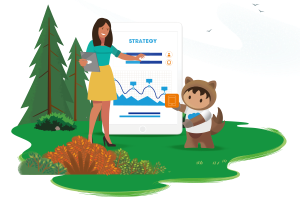The only certainty is change and businesses that can adapt and innovate quickly succeed in the long term. Agile businesses that leverage new principles, practices and technology can create flexible workflows that revolutionise how their solutions are developed and delivered.
Over the last three decades, agile methodology has skyrocketed success rates in software development. But the agile approach is catching fire across the business world, and there is growing recognition of its transformational benefits for organisations and their staff. An agile business combines speed and adaptability with stability and efficiency, the key ingredients to make your small business future-proofed. Agile methods will also boost team motivation and productivity, improving quality, and accelerating the time to market.
Get your SME Ready for the Future
This guide will take you through what you need to future-proof your small business from two perspectives: people and technology.

But what does being agile really mean?
Agility, when applied to business isn’t a prescriptive method, but rather a disciplined, yet flexible approach that manages change in a swift and dynamic way.
Unlike traditional “waterfall practices” – where everything is planned upfront and tasks flow through a rigid step-by-step process – agile processes embrace change.
When businesses adopt an agile approach to manage processes and run operations, teams can build deliverables incrementally, instead of being forced to deliver one final finished product at the end. Removing boundaries and encouraging problem-solving means teams can align, measure and manage progress consistently and quickly, and deliver more value to the customer. Equally, if the business landscape shifts unexpectedly, an agile business is able to swiftly pivot and adapt to change.
When agile works best: Supporting adaptive business strategy
Businesses that 1) are already highly receptive to change, 2) foster a learning environment, and 3) are focused on delivering value to customers quickly – can benefit the most from operating and innovating in an agile way. Here is how you can apply cornerstones of the methodology and mindset into your SME strategic approach:
Embracing uncertainty
A business needs to be successful to survive. Risk aversion is only natural. Yet, in a fast-changing and unpredictable business environment, it can backfire. That’s why the agile approach embraces uncertainty and encourages experimentation.
In an agile process, risk is assessed in short development cycles that reduce complexity, mitigate threats and allow teams to quickly deliver solutions in increments.
People over processes
Whether internal or external, good personal relationships are key to success in agile projects.
Admittedly, customer segments are not as clear-cut as they once used to be. Customers demand greater levels of individuality and their perceptions, needs and behaviours all influence boundaries. It’s therefore crucial that businesses tune into trends and use agile methods to gain a deeper insight into customers, build robust relationships and earn loyalty.
Make mistakes. Learn. Move forward.
Experimentation always involves a degree of failure. The agile approach embraces these errors as an opportunity to learn. This environment empowers teams to make decisions, learn from mistakes and innovate to improve products and processes.
Our own scrum process at Salesforce embodies this philosophy and enables us to learn in real time, so we can quickly correct any potential damage that may result from managed risk-taking.
Inspire to Excel
While the agile approach is flexible, it requires strong leadership.
Entrepreneurs and small business leaders who switch from working in silos to a cross-functional, agile team approach, step away from micromanagement. A good agile leader protects the team from distractions and inefficient processes, removes blockers, and empowers people to use their collective intelligence to quickly achieve goals.
Harness the power of dynamic strategy
External factors – like market pressure, new regulations, and economic and social changes – mean businesses need to be flexible and responsive to fluctuating conditions, now more than ever.
The best business plans are living documents that can be adjusted as a small business expands and evolves. Dynamic strategies provide real-time data and support collaboration, enabling SMEs to respond better and faster to opportunities and challenges.
Work flexibly with agile technology
A fluid, agile workplace is also supported by virtual teams and flexible productivity tools, such as a cloud-based Customer Relationship Management tool (CRM), a project management tool, and the right communication app. In addition to supporting collaboration from different locations, these tools clearly identify the direction of tasks help teams monitor progress and can scale up as the business grows. Digital tools also allow for updates and additions as new technology trends emerge.
Future-proof your SME with an Agile Business Strategy
In this fast-paced, changing world, small and medium-sized businesses need to be agile to succeed – today and tomorrow. From inspiring new ways of working to developing products and services, agile teams help companies achieve goals more effectively.
Adopting an agile mindset for your small business comes with many benefits, including better collaboration and communication, greater efficiency and accuracy, and improved idea flow and troubleshooting, boosting customer satisfaction.
Are you ready to give your small business the agility it needs to react to changing circumstances and keep on thriving? Our latest eBook “Get Your SME Ready for the Future” offers insights on how people and tech play a vital role in fortifying your business for future growth and challenges.

























